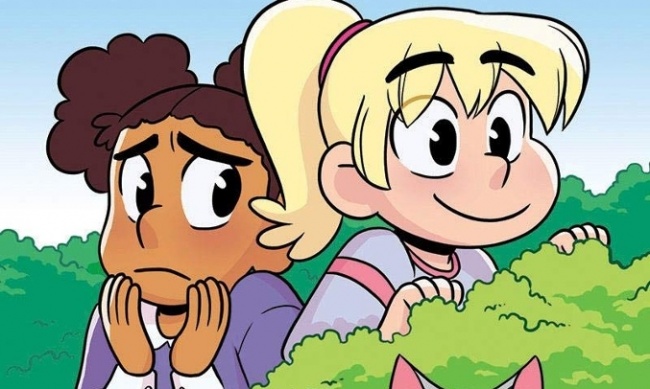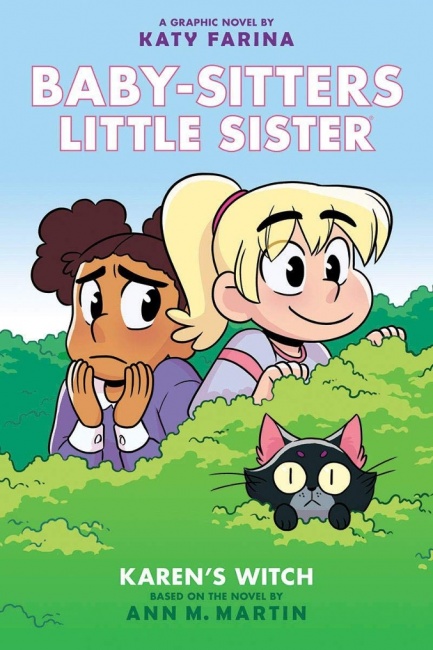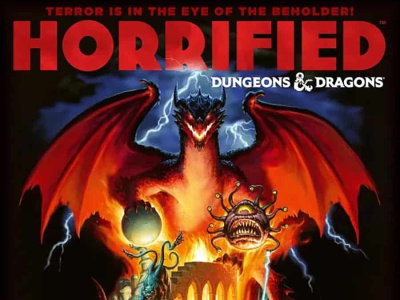Baby-Sitters Little Sister: Karen’s Witch GN
Publisher: Scholastic Graphix
Release Date: December 26, 2019
Price: $10.99 (TP) / $18.99 (HC)
Creator(s): Ann M. Martin and Katy Farina
Format: 144 pgs., Full-Color, 6"x9", Trade Paperback/Hardcover
ISBN: 978-1-338-31519-6 (TP) / 978-1-338-35611-3 (HC)
Age Rating: 7-10
ICv2 Rating: 4 Stars out of 5
Having created a highly successful franchise with their graphic adaptations of the Baby-Sitters Club chapter books, Scholastic is now branching out with a spinoff aimed at younger readers (and based on an existing spinoff of the original prose series). This volume also marks the series debut of Katy Farina, who will be the artist for the first four Baby-Sitters Little Sister books.
The story, which is based on the first Baby-Sitters Little Sister novel, is a bit cringe-inducing: Six-year-old Karen is convinced her father’s next-door neighbor is a witch. In fact, the neighbor is simply an old woman who enjoys gardening, but Karen’s obsession leads her to not only spy on the neighbor but drag her friend into a confrontation when she invades what she thinks is a witches’ coven—but turns out to be a gardening club meeting.
If the plot is a bit weak, that’s on the original material. Farina does a good job of not just adapting the material but doing so in a way that is well suited to younger readers who may be encountering their first comic. The character designs are simple, and the children really look like children. Super cute children with huge, expressive eyes! She uses detail only where necessary, so the overall art doesn’t feel cluttered or busy. And she does some nice things with paneling: Overlaying panels over a larger scene, changing point of view, focusing in tight on the faces. In fact, she often uses silent panels to allow the reader to really see the characters’ emotions. She also likes to put two panels with similar scenes side by side, so the reader can look from one to the other and see what changes.
Although the book is only 144 pages long, the story moves slowly until close to the end. Rather than feeling tedious, though, it feels immersive. The reader is watching Karen and her family as they go about their lives, and thus gets to participate vicariously. It’s worth noting that Karen is in a blended family, and a very happy one at that. At the beginning of the book she says she is "lucky" to be the child of divorced and remarried parents, because she has two of everything, including toys and birthday parties. Aside from the central conflict of the story, everyone gets along and nobody whines or complains. It’s a perfect world, except for the witch next door.
The target audience for this book is young middle-grade readers, ages 7 to 10, and it’s the nature of the material that it will probably have stronger appeal to girls than to boys.
--Brigid Alverson

ICv2 Stars: 4 (out of 5)
Posted by Brigid Alverson on December 5, 2019 @ 7:07 pm CT
MORE COMICS
Part of 1996 Marvel/DC Crossover
August 1, 2025
Writer Karl Kesel and artist Mike Wieringo are the creative team for the one-shot comic, which was first published in 1996 in the middle of a Marvel/DC crossover.
Crowdfunding Campaign Launches in October, Followed by Retail Release
August 1, 2025
Vault will crowdfund the graphic novel on the Backerkit platform in October, then release it to retail.
MORE REVIEWS
ICv2 Stars: 3.5 (out of 5)
July 30, 2025
Here is a review of Ravensburger's Horrified: Dungeons & Dragons.
ICv2 Stars: 3.5 (out of 5)
July 24, 2025
Check out the review of Disney Villainous: Treacherous Tides, from Ravensburger.








